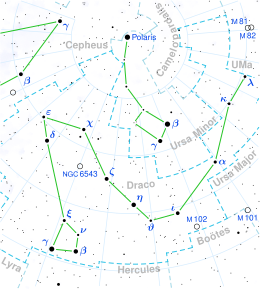Lambda Draconis (λ Draconis, abbreviated Lam Dra, λ Dra), also named Giausar (/ˈdʒɔːzɑːr/ JAW-zar),[11][12] is a solitary,[13] orange-red[14] star in the northern circumpolar constellation of Draco. It is visible to the naked eye with an apparent visual magnitude of +3.85.[2] Based upon an annual parallax shift of 9.79 mas as seen from the Earth,[1] the star is located around 333 light years from the Sun.
| Observation data Epoch J2000.0 Equinox J2000.0 (ICRS) | |
|---|---|
| Constellation | Draco |
| Right ascension | 11h 31m 24.22075s[1] |
| Declination | +69° 19′ 51.8696″[1] |
| Apparent magnitude (V) | +3.85[2] |
| Characteristics | |
| Evolutionary stage | asymptotic giant branch[3] |
| Spectral type | M0III-IIIa Ca1[4] |
| U−B color index | +1.97[2] |
| B−V color index | +1.62[2] |
| Variable type | slow irregular[5] |
| Astrometry | |
| Radial velocity (Rv) | +6.58±0.30[6] km/s |
| Proper motion (μ) | RA: −40.97[1] mas/yr Dec.: −19.19[1] mas/yr |
| Parallax (π) | 9.79 ± 0.15 mas[1] |
| Distance | 333 ± 5 ly (102 ± 2 pc) |
| Absolute magnitude (MV) | −1.14±0.033[7] |
| Details[8] | |
| Mass | 1.53±0.12 M☉ |
| Radius | 69.99+1.06 −1.10 R☉ |
| Luminosity | 884±52 L☉ |
| Surface gravity (log g) | 1.10±0.05[9] cgs |
| Temperature | 3,761±47 K |
| Metallicity [Fe/H] | 0.00 dex |
| Age | 2.33±0.48 Gyr |
| Other designations | |
| Database references | |
| SIMBAD | data |
This is an evolved red giant star on the asymptotic giant branch[3] with a stellar classification of M0III-IIIa Ca1.[4] It is a suspected slow irregular variable with a periodicity of roughly 1,100 days.[5] It has an estimated 1.53 times the mass of the Sun and a measured radius of 70 times the radius of the Sun. It is radiating 884 times the solar luminosity from its photosphere at an effective temperature of 3,761 K.[8]
Nomenclature
editλ Draconis (Latinised to Lambda Draconis) is the star's Bayer designation.
It bore the traditional name Giausar[15] (also written as Gianfar, Giansar and Giauzar) and Juza. In 2016, the International Astronomical Union organized a Working Group on Star Names (WGSN)[16] to catalogue and standardize proper names for stars. The WGSN approved the name Giausar for this star on February 1, 2017, and it is now so included in the List of IAU-approved Star Names.[12]
In Chinese, 紫微右垣 (Zǐ Wēi Yòu Yuán), meaning Right Wall of Purple Forbidden Enclosure, refers to an asterism consisting of Lambda Draconis, Alpha Draconis, Kappa Draconis, 24 Ursae Majoris, 43 Camelopardalis, Alpha Camelopardalis and BK Camelopardalis.[17] Consequently, the Chinese name for Lambda Draconis itself is 紫微右垣三 (Zǐ Wēi Yòu Yuán sān, English: the Third Star of Right Wall of Purple Forbidden Enclosure.),[18] representing 上輔 (Shǎngfǔ), meaning First Minister.[19] 上輔 (Shǎngfǔ) was westernized into Sang Poo or Shaou Poo by R.H. Allen.[20]
Namesakes
editUSS Giansar (AK-111) was a United States Navy Crater class cargo ship named after the star.
References
edit- ^ a b c d e f van Leeuwen, F. (2007), "Validation of the new Hipparcos reduction", Astronomy and Astrophysics, 474 (2): 653–664, arXiv:0708.1752, Bibcode:2007A&A...474..653V, doi:10.1051/0004-6361:20078357, S2CID 18759600.
- ^ a b c d Johnson, H. L.; et al. (1966), "UBVRIJKL photometry of the bright stars", Communications of the Lunar and Planetary Laboratory, 4 (99): 99, Bibcode:1966CoLPL...4...99J.
- ^ a b Eggen, O. J. (1992). "Asymptotic giant branch stars near the sun". The Astronomical Journal. 104: 275. Bibcode:1992AJ....104..275E. doi:10.1086/116239.
- ^ a b Keenan, Philip C.; McNeil, Raymond C. (1989), "The Perkins catalog of revised MK types for the cooler stars", Astrophysical Journal Supplement Series, 71: 245, Bibcode:1989ApJS...71..245K, doi:10.1086/191373, S2CID 123149047.
- ^ a b Samus, N. N.; Durlevich, O. V.; et al. (2007), Combined General Catalogue of Variable Stars (GCVS4.2), retrieved 2016-09-30.
- ^ Famaey, B.; et al. (2009), "Spectroscopic binaries among Hipparcos M giants,. I. Data, orbits, and intrinsic variations", Astronomy and Astrophysics, 498 (2): 627–640, arXiv:0901.0934, Bibcode:2009A&A...498..627F, doi:10.1051/0004-6361/200810698, S2CID 18739721.
- ^ Park, Sunkyung; et al. (2013), "Wilson-Bappu Effect: Extended to Surface Gravity", The Astronomical Journal, 146 (4): 73, arXiv:1307.0592, Bibcode:2013AJ....146...73P, doi:10.1088/0004-6256/146/4/73, S2CID 119187733.
- ^ a b Baines, Ellyn K.; et al. (2018), "Fundamental Parameters of 87 Stars from the Navy Precision Optical Interferometer", The Astronomical Journal, 155 (1), 30, arXiv:1712.08109, Bibcode:2018AJ....155...30B, doi:10.3847/1538-3881/aa9d8b, S2CID 119427037.
- ^ Takagi, Yuhei; et al. (June 2011), "Age Determinations of Early-M Type Pre-Main Sequence Stars Using a High-Resolution Near-Infrared Spectroscopic Method", Publications of the Astronomical Society of Japan, 63 (3): 677–684, Bibcode:2011PASJ...63..677T, doi:10.1093/pasj/63.3.677.
- ^ "lam Dra". SIMBAD. Centre de données astronomiques de Strasbourg. Retrieved 2017-05-28.
{{cite web}}: CS1 maint: postscript (link) - ^ Kunitzsch, Paul; Smart, Tim (2006). A Dictionary of Modern star Names: A Short Guide to 254 Star Names and Their Derivations (2nd rev. ed.). Cambridge, Massachusetts: Sky Pub. ISBN 978-1-931559-44-7.
- ^ a b "Naming Stars". IAU.org. Retrieved 16 December 2017.
- ^ Eggleton, P. P.; Tokovinin, A. A. (September 2008), "A catalogue of multiplicity among bright stellar systems", Monthly Notices of the Royal Astronomical Society, 389 (2): 869–879, arXiv:0806.2878, Bibcode:2008MNRAS.389..869E, doi:10.1111/j.1365-2966.2008.13596.x, S2CID 14878976.
- ^ Moore, Patrick (2013), The Observer's Year: 366 Nights of the Universe, The Patrick Moore Practical Astronomy Series, Springer Science & Business Media, p. 285, ISBN 978-1447136132
- ^ Kaler, James B., "Giausar", stars.astro.illinois.edu, retrieved 2017-05-28.
- ^ "International Astronomical Union | IAU". www.iau.org. Retrieved 2017-03-31.
- ^ (in Chinese) 中國星座神話, written by 陳久金. Published by 台灣書房出版有限公司, 2005, ISBN 978-986-7332-25-7.
- ^ (in Chinese) 香港太空館 - 研究資源 - 亮星中英對照表 Archived 2008-10-25 at the Wayback Machine, Hong Kong Space Museum. Accessed on line November 23, 2010.
- ^ English-Chinese Glossary of Chinese Star Regions, Asterisms and Star Name Archived 2008-09-24 at the Wayback Machine, Hong Kong Space Museum. Accessed on line November 23, 2010.
- ^ Allen, Richard Hinckley (1963), Star Names — Their Lore and Meaning: Draco, the Dragon, retrieved 2017-05-28.
